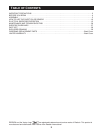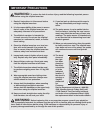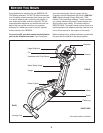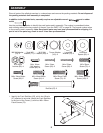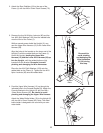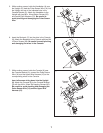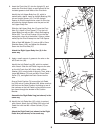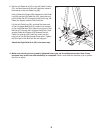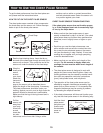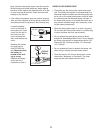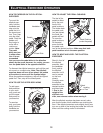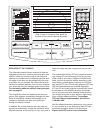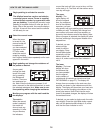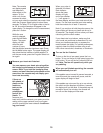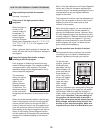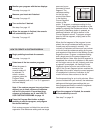
10
To get the best performance from the chest pulse sen-
sor, please read the instructions below.
H
OW TO PUT ON THE CHEST PULSE SENSOR
The chest pulse sensor consists of two components:
the chest strap and the sensor unit. Follow the steps
below to put on the chest pulse sensor.
See the inset drawing above. Insert the tab on
one end of the chest strap through one end of the
sensor unit as shown. Then, press the end of the
sensor unit under the buckle on the chest strap.
Wrap the
chest pulse
sensor
around
your chest.
Attach the
free end of
the chest
strap to the sensor unit as described above.
Adjust the length of the chest strap, if necessary.
The chest pulse sensor should be under your
clothing, against your skin, and as high under the
pectoral muscles or breasts as is comfortable.
Make sure that the logo is facing forward and is
right-side-up.
Pull the
sensor unit
away from
your body
a few inch-
es and
locate the
two elec
-
trode areas on the inner side. Using a saline
solution such as saliva or contact lens solution,
wet both electrode areas. Return the sensor unit
to a position against your chest.
CHEST PULSE SENSOR TROUBLESHOOTING
If the chest pulse sensor does not function proper-
ly, or if the displayed heart rate is excessively high
or low, try the steps below.
• Make sure that the chest pulse sensor is worn
exactly as described in step 2 at the left. If the chest
pulse sensor does not function when positioned as
described, move it slightly lower or higher on your
chest.
•
Each time you use the chest pulse sensor, use
saline solution such as saliva or contact lens solu-
tion to wet the two electrode areas on the sensor
unit (see the drawing in step 3 below). If heart rate
readings do not appear until you begin perspiring,
re-wet the electrode areas.
• Make sure that you are within arm’s length of the
console.
For the console to display heart rate
readings, the user must be within arm’s length of
the console.
• The chest pulse sensor is designed to work with
people who have normal heart rhythms. Heart rate
reading problems may be caused by medical condi-
tions such as premature ventricular contractions
(pvcs), tachycardia bursts, and arrhythmia.
• The operation of the chest pulse sensor can be
affected by magnetic interference caused by high
power lines or other sources. If it is suspected that
magnetic interference may be causing a problem,
try relocating the elliptical exerciser.
• If the chest pulse sensor still does not function prop-
erly, test the chest pulse sensor in the following way:
Hold the chest
pulse sensor
and place your
thumbs over
the electrode
areas as
shown.
3
2
1
Chest Strap
Sensor Unit
Tab
Buckle
Logo
Electrode Areas
Sensor
Unit
Electrode
Areas
HOW TO USE THE CHEST PULSE SENSOR



